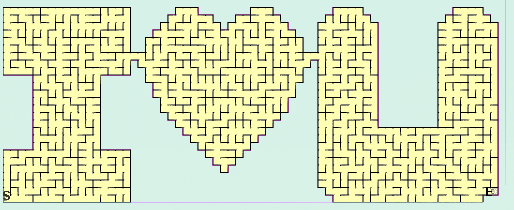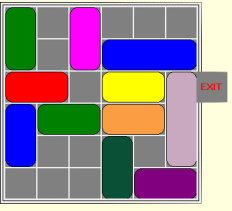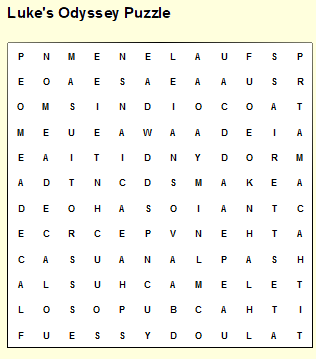What's New - March, 2008
[Home]
March 30, 2008: I discovered this morning that some scumbag is using my feedback address as the "From" address for an email pitch to sell genuine replica watches. I haven't received any orders yet, just half a dozen automated "undeliverable" or "this is spam" replies. I decided to post here to disclaim responsibility and assure any irritated recipients had that we do not sell watches here; we give away the idea that curiosity, analysis, and critical thinking are good habits to acquire.
 |
| A maze created for my granddaughters |
March 22: 2008: Our Maze program was originally
written in 2001 and has not had an update in several years. It allows users
to generate and solve or print mazes of arbitrary shape and
complexity. Today's update was to help a programmer who wants to make some
changes to the program. Maze Version 2
makes it easier to recompile the program on a standard Delphi system and
fixes a few other small bugs. The original write-up was made before I
realized that many non-programmers might also be interested in these
programs, so the descriptive text concentrates on the code. But
if you download the executable and play with it, I'm sure you can figure it
out.

March 15, 2008: A month or so ago we visited my
daughter and her family in Connecticut. I've already implemented
grandson Luke's improvements for the WordSearch puzzle generator. Today
I posted another enhancement suggestion of his for our Traffic Jam program, a
Delphi implementation of
Binary Arts' Rush Hour Puzzle. In Luke's
version shown a left, the Yellow car blocks the Red car (which must reach
the exit to win), and travels in the same row as the Red car. Luke says
that some of the advanced sets of "Rush Hour" puzzle card packs use this
complication, but we couldn't find any in his collection. In any event,
Traffic Jam Version 1.1 posted today
allows user play and computer solution of this case and others like it.

March 13, 2008: A modified version of our "Monitor Power Off" program was posted today to optionally issue either a Standby or Poweroff command when the pause key is pressed. ("Standby" doesn't work on some systems.)
A little "March Madness" has struck here:
Go Duke!
March 8, 2008:
 |
One of the bittersweet aspects
of growing older is the realization that, sooner or later, your
grandchildren will be smarter than you. During recent visit,
grandson Luke came into the living room one evening with copies of a
WordSearch puzzle he had created as a homework assignment. The words
to be found were from a list provided by his teacher from their current
reading project, a little tome entitled "The Odyssey"! He is 11
years old and in the 6th grade by the way. I'll admit that reading
"The Odyssey" is still on my To-Do list, and nowhere near the top.
The entire family had to find the words in Luke's puzzle and I came in dead
last. But at least I did pick up a couple of his techniques that I
added to Version 3.1 of our Crossword
Generator program (which also builds WordSearch puzzles).
Luke included fake partial words to lead you down the wrong path and he also
preferred inverted, backwards, and inverted-backwards orientations
over those easier to find. I've tried to incorporate both of
these features in this version. The
puzzle at right is from my program - not as good a Luke's but still contains
his word list (TELEMACHUS, LACEDAEMON. PHAEACIANS, ODYSSEUS, MENELAUS,
POSEIDON, ATHENA, ITHACA, NAIADS, SUITORS).
March 3, 2008:
![]()
You are given four piles of blocks, each 6 blocks high and containing the letters "A" through "F". These are scrambled versions of the unknown "Solution" stack. For each of the 4 stacks, you are also given the number of pairs that have a match in the solution stack and the number of pairs that are reversed versions of pairs in the solution stack. Your job is to reconstruct the solution stack. If you are really quick, you can do it the way Pile Up Puzzle does it - just check each the 720 possible arrangements of 6 letters to find one that has the specified number of matching and reversed pairs when matched against each of the given stacks. (The computer averages about 0.002 seconds to do this.)
